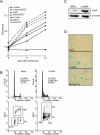Viral oncogene-induced DNA damage response is activated in Kaposi sarcoma tumorigenesis
- PMID: 17907806
- PMCID: PMC1994968
- DOI: 10.1371/journal.ppat.0030140
Viral oncogene-induced DNA damage response is activated in Kaposi sarcoma tumorigenesis
Abstract
Kaposi sarcoma is a tumor consisting of Kaposi sarcoma herpesvirus (KSHV)-infected tumor cells that express endothelial cell (EC) markers and viral genes like v-cyclin, vFLIP, and LANA. Despite a strong link between KSHV infection and certain neoplasms, de novo virus infection of human primary cells does not readily lead to cellular transformation. We have studied the consequences of expression of v-cyclin in primary and immortalized human dermal microvascular ECs. We show that v-cyclin, which is a homolog of cellular D-type cyclins, induces replicative stress in ECs, which leads to senescence and activation of the DNA damage response. We find that antiproliferative checkpoints are activated upon KSHV infection of ECs, and in early-stage but not late-stage lesions of clinical Kaposi sarcoma specimens. These are some of the first results suggesting that DNA damage checkpoint response also functions as an anticancer barrier in virally induced cancers.
Conflict of interest statement
Figures






Similar articles
-
Demonstration of Kaposi's sarcoma-associated herpes virus cyclin D homolog in cutaneous Kaposi's sarcoma by colorimetric in situ hybridization using a catalyzed signal amplification system.Blood. 1998 May 15;91(10):3825-32. Blood. 1998. PMID: 9573020
-
The role of Kaposi sarcoma-associated herpesvirus in the pathogenesis of Kaposi sarcoma.J Pathol. 2015 Jan;235(2):368-80. doi: 10.1002/path.4441. J Pathol. 2015. PMID: 25212381 Review.
-
Kaposi's Sarcoma-Associated Herpesvirus Infection Induces the Expression of Neuroendocrine Genes in Endothelial Cells.J Virol. 2020 Mar 31;94(8):e01692-19. doi: 10.1128/JVI.01692-19. Print 2020 Mar 31. J Virol. 2020. PMID: 31969437 Free PMC article.
-
Kaposi's sarcoma-associated herpesvirus induces Nrf2 during de novo infection of endothelial cells to create a microenvironment conducive to infection.PLoS Pathog. 2014 Oct 23;10(10):e1004460. doi: 10.1371/journal.ppat.1004460. eCollection 2014 Oct. PLoS Pathog. 2014. PMID: 25340789 Free PMC article.
-
Kaposi's sarcoma herpesvirus-induced endothelial cell reprogramming supports viral persistence and contributes to Kaposi's sarcoma tumorigenesis.Curr Opin Virol. 2017 Oct;26:156-162. doi: 10.1016/j.coviro.2017.09.002. Epub 2017 Oct 12. Curr Opin Virol. 2017. PMID: 29031103 Review.
Cited by
-
IFI16 acts as a nuclear pathogen sensor to induce the inflammasome in response to Kaposi Sarcoma-associated herpesvirus infection.Cell Host Microbe. 2011 May 19;9(5):363-75. doi: 10.1016/j.chom.2011.04.008. Cell Host Microbe. 2011. PMID: 21575908 Free PMC article.
-
Modulation of DNA damage and repair pathways by human tumour viruses.Viruses. 2015 May 22;7(5):2542-91. doi: 10.3390/v7052542. Viruses. 2015. PMID: 26008701 Free PMC article. Review.
-
Immune evasion in Kaposi's sarcoma-associated herpes virus associated oncogenesis.Semin Cancer Biol. 2008 Dec;18(6):423-36. doi: 10.1016/j.semcancer.2008.09.003. Epub 2008 Oct 2. Semin Cancer Biol. 2008. PMID: 18948197 Free PMC article. Review.
-
Interplay between Kaposi's sarcoma-associated herpesvirus and the innate immune system.Cytokine Growth Factor Rev. 2014 Oct;25(5):597-609. doi: 10.1016/j.cytogfr.2014.06.001. Epub 2014 Jun 21. Cytokine Growth Factor Rev. 2014. PMID: 25037686 Free PMC article. Review.
-
Tampering of Viruses and Bacteria with Host DNA Repair: Implications for Cellular Transformation.Cancers (Basel). 2021 Jan 11;13(2):241. doi: 10.3390/cancers13020241. Cancers (Basel). 2021. PMID: 33440726 Free PMC article. Review.
References
-
- Bartkova J, Rezaei N, Liontos M, Karakaidos P, Kletsas D, et al. Oncogene-induced senescence is part of the tumorigenesis barrier imposed by DNA damage checkpoints. Nature. 2006;444:633–637. - PubMed
-
- Gorgoulis VG, Vassiliou LV, Karakaidos P, Zacharatos P, Kotsinas A, et al. Activation of the DNA damage checkpoint and genomic instability in human precancerous lesions. Nature. 2005;434:907–913. - PubMed
-
- Vafa O, Wade M, Kern S, Beeche M, Pandita TK, et al. c-Myc can induce DNA damage, increase reactive oxygen species, and mitigate p53 function: A mechanism for oncogene-induced genetic instability. Mol Cell. 2002;9:1031–1044. - PubMed
-
- Lindstrom MS, Wiman KG. Myc and E2F1 induce p53 through p14ARF-independent mechanisms in human fibroblasts. Oncogene. 2003;22:4993–5005. - PubMed
-
- Di Micco R, Fumagalli M, Cicalese A, Piccinin S, Gasparini P, et al. Oncogene-induced senescence is a DNA damage response triggered by DNA hyper-replication. Nature. 2006;444:638–642. - PubMed
Publication types
MeSH terms
Substances
LinkOut - more resources
Full Text Sources
Medical

